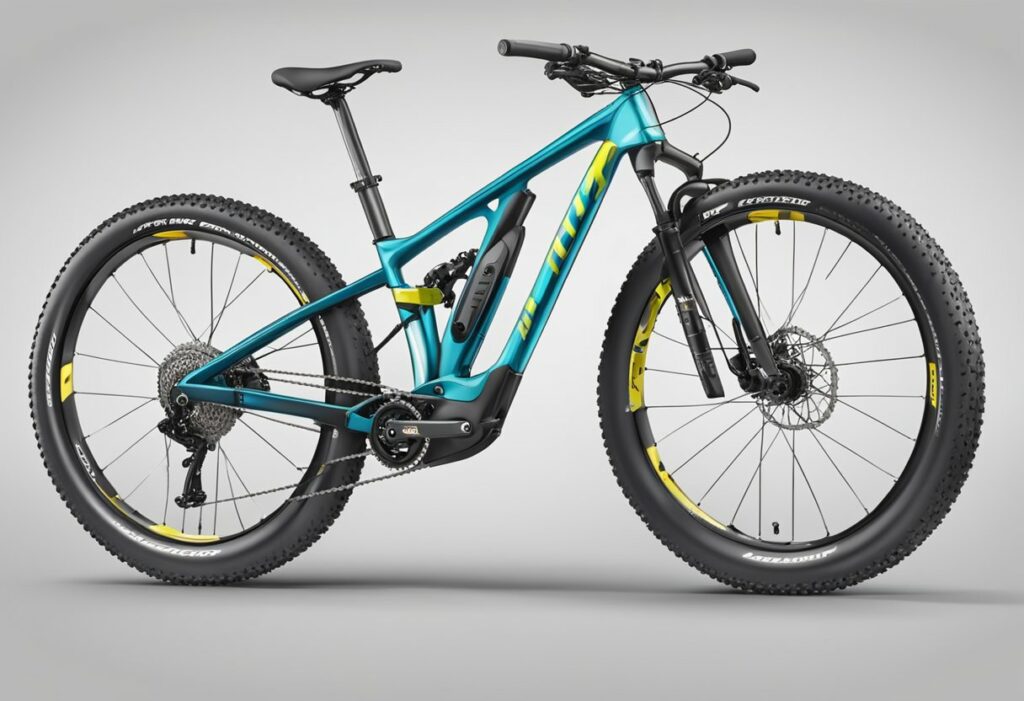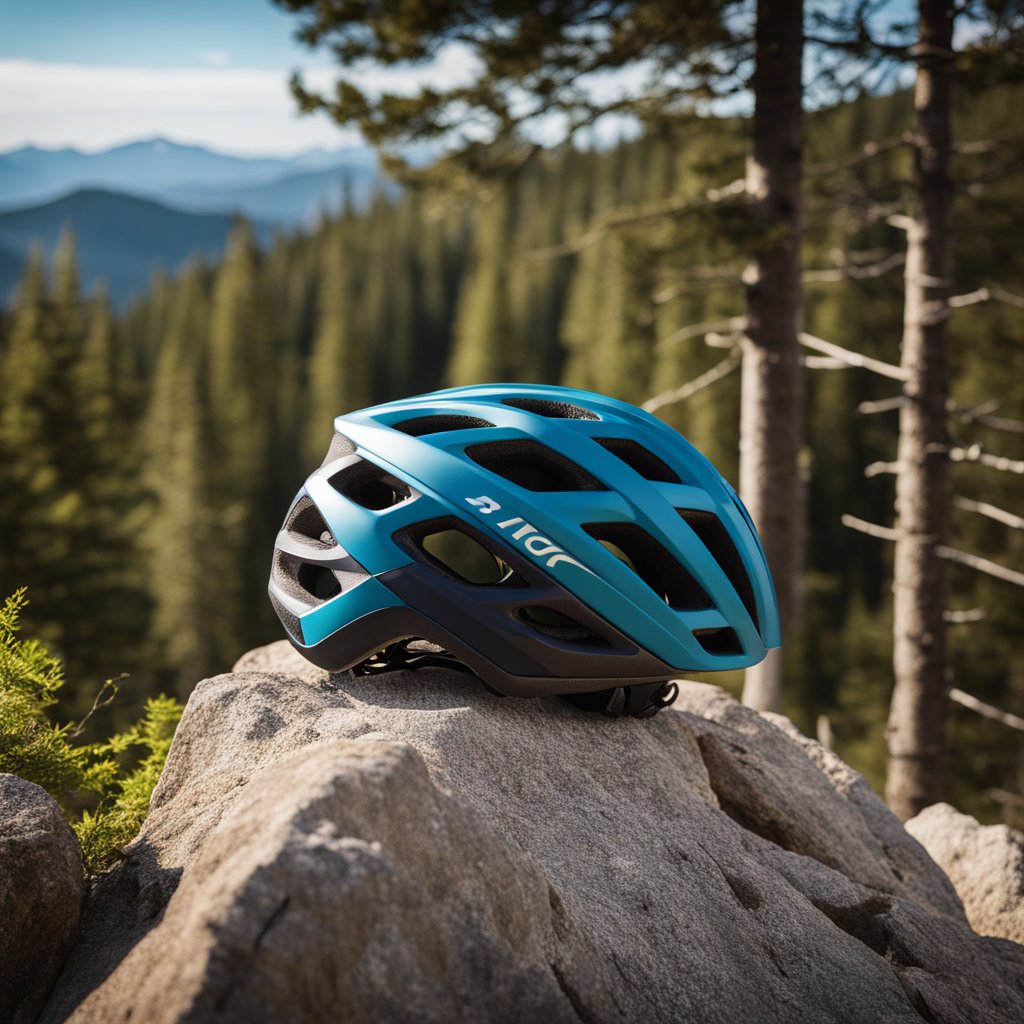Understanding Mountain Bike Types
When choosing the right mountain bike, it’s important to understand the different types available. Each type of mountain bike is designed for a specific purpose, and choosing the right one can make a big difference in your riding experience.
Hardtail Versus Full-Suspension
One of the first decisions you’ll need to make when choosing a mountain bike is whether you want a hardtail or a full-suspension bike. Hardtail bikes have a suspension fork on the front but no rear suspension, while full-suspension bikes have both front and rear suspension. Hardtail bikes are generally less expensive and more efficient for climbing, while full-suspension bikes are more comfortable and better for technical descents.

Specialized Mountain Bikes: XC, Enduro, and Downhill
Once you’ve decided between a hardtail and full-suspension bike, you’ll need to choose the right type of mountain bike for your riding style. There are three main types of specialized mountain bikes: cross-country (XC), enduro, and downhill.
Cross-Country (XC) Bikes
Cross-country bikes are designed for racing and long-distance riding on smooth trails. They are typically lightweight and efficient, with less suspension travel than other types of mountain bikes. XC bikes are a good choice if you want to cover a lot of ground quickly.
Enduro Bikes
Enduro bikes are designed for aggressive riding on technical terrain. They have more suspension travel than XC bikes and are built to handle steep descents and jumps. Enduro bikes are a good choice if you want to ride challenging trails and compete in enduro races.
Downhill Bikes
Downhill bikes are designed for riding downhill at high speeds on extremely technical terrain. They have the most suspension travel of any type of mountain bike and are built to handle the biggest jumps and drops. Downhill bikes are a good choice if you want to ride bike parks and compete in downhill races.
Electric Mountain Bikes
Electric mountain bikes, also known as e-bikes, are a relatively new type of mountain bike that use an electric motor to assist with pedaling. They are a good choice if you want to ride longer distances or tackle more challenging terrain without getting as tired. E-bikes are available in all three types of mountain bikes: XC, enduro, and downhill.
All-Mountain Bikes
All-mountain bikes are designed to handle a wide range of terrain, from smooth trails to technical descents. They have more suspension travel than XC bikes but less than enduro or downhill bikes. All-mountain bikes are a good choice if you want one bike that can handle all types of riding.
In summary, choosing the right mountain bike type depends on your riding style, the type of terrain you’ll be riding on, and your budget. Consider the different types of mountain bikes available and choose the one that best fits your needs.
Finding the Right Fit

Choosing the right mountain bike size and fit is critical to having a comfortable and enjoyable riding experience. Here are some essential things to consider when finding the right fit:
Importance of Bike Sizing
Getting the right bike size is crucial for your comfort and safety on the trails. A bike that is too small or too large can cause discomfort, make it difficult to control the bike, and increase the risk of injury. Therefore, it is essential to choose the right bike size based on your height, inseam, and riding style.
Frame Size and Geometry
The frame size and geometry of your mountain bike play a significant role in how it fits and feels. The frame size determines the height of the bike, and the geometry affects the bike’s handling and stability. Mountain bikes come in different frame sizes, and it is essential to choose the right size based on your height and inseam.
The effective top tube length and standover height are also critical factors to consider when choosing the right frame size. The effective top tube length determines how far you need to reach to the handlebars, and the standover height determines how high the bike’s top tube is from the ground.
Moreover, the frame material also influences the bike’s weight, durability, and stiffness. Aluminum and carbon fiber are the most common materials used for mountain bike frames. Aluminum is affordable, durable, and lightweight, while carbon fiber is lightweight, stiff, and provides excellent shock absorption.
Bike Sizing and Fit
To ensure you get the right size and fit, you can use a mountain bike size chart or a bike fit calculator. These tools help you determine the right frame size based on your height, inseam, and riding style. You can also seek help from a skilled bike tech or sales associate to help you choose the right size bike and personalize the fit.
Once you have the right size, you can fine-tune the fit with simple adjustments to the bike’s existing components, such as seat height and seat angle. You can also swap out components to make the bike fit better.
In conclusion, finding the right fit for your mountain bike is crucial for your comfort, safety, and enjoyment on the trails. Take your time to consider your height, inseam, riding style, and frame size and geometry when choosing the right bike size. Use a mountain bike size chart or a bike fit calculator to help you determine the right size and seek help from a skilled bike tech or sales associate if needed.
Selecting the Appropriate Components

Selecting the appropriate components for your mountain bike is crucial for ensuring an enjoyable and safe ride. When it comes to components, there are a few key areas to consider: drivetrain and brakes, suspension, and tires.
Drivetrain and Brakes
The drivetrain and brakes are two of the most important components of your mountain bike. The drivetrain consists of the pedals, cranks, chain, cassette, and derailleur. It is responsible for transferring your pedal power to the wheels. The number of gears and gear ratios will depend on the type of riding you plan on doing. If you plan on tackling steep inclines, you may want to consider a drivetrain with a wider range of gears.
The brakes are responsible for stopping your bike and are essential for maintaining control on the trails. There are two main types of brakes: rim brakes and disc brakes. Disc brakes provide more stopping power and are better suited for mountain biking. When choosing your brakes, consider the type of terrain you will be riding on and the level of stopping power you will need.
Suspension and Tires
The suspension and tires are responsible for providing traction and absorbing shock. Suspension travel refers to the amount of travel your suspension forks and rear shock can handle. If you plan on riding technical terrain or going downhill, you may want to consider a bike with more suspension travel.
Suspension forks are responsible for absorbing shock and come in two types: air and coil. Air forks are lighter and more adjustable, while coil forks are more durable and require less maintenance. Dropper posts are another important component to consider. They allow you to adjust your seat height on the fly, which is essential for technical terrain.
Tires are also important for providing traction and absorbing shock. The type of tire you choose will depend on the type of terrain you will be riding on. If you plan on riding on rocky terrain, you may want to consider a tire with more aggressive tread.
In conclusion, selecting the appropriate components for your mountain bike is essential for ensuring an enjoyable and safe ride. When choosing your components, consider the type of riding you plan on doing and the terrain you will be riding on. By choosing the right components, you can ensure that your mountain bike is up to the task.
Material Matters: Choosing the Right Frame

When it comes to mountain bike frames, there are several materials to choose from, each with its own pros and cons. In this section, we’ll go over the most popular materials and help you choose the right one for your needs.
Pros and Cons of Different Materials
Carbon
Carbon is a popular choice for high-end mountain bikes due to its lightweight build and stiffness. Carbon frames are made by layering sheets of carbon fiber, which is then bonded together with resin. The result is a frame that is incredibly strong and durable, yet lightweight.
Pros:
- Lightweight build
- Stiff and responsive
- Durable
Cons:
- Expensive
- Can be easily damaged from impacts
- Difficult to repair
Aluminum
Aluminum is a popular choice for mountain bike frames due to its affordability and durability. It is a lightweight material that is easy to work with, making it a great choice for entry-level mountain bikes.
Pros:
- Affordable
- Durable
- Lightweight
Cons:
- Can be stiff and uncomfortable on rough terrain
- Less comfortable than carbon or titanium
Steel
Steel is a classic material that has been used for bike frames for decades. It is known for its durability and comfort, making it a great choice for long rides.
Pros:
- Comfortable ride
- Durable
- Affordable
Cons:
- Heavy
- Can be less responsive than other materials
Titanium
Titanium is a premium material that offers a great balance of strength, durability, and weight. It is often used for high-end mountain bikes due to its unique properties.
Pros:
- Strong and durable
- Lightweight
- Comfortable ride
Cons:
- Expensive
- Difficult to work with
Carbon vs Aluminum vs Steel vs Titanium
When it comes to choosing the right material for your mountain bike frame, it ultimately comes down to personal preference and budget. Carbon is the most expensive option, but it offers the best combination of stiffness and lightweight build. Aluminum is a great choice for entry-level mountain bikes due to its affordability and durability. Steel is a classic material that offers a comfortable ride but can be heavy. Titanium is a premium material that offers a great balance of strength, durability, and weight.
In conclusion, when choosing the right material for your mountain bike frame, it’s important to consider your budget, riding style, and personal preferences. Each material has its own unique properties, so take the time to research and test ride different options to find the best fit for you.
Budgeting for Your Mountain Bike

When it comes to buying a mountain bike, setting a budget is essential. You want to make sure you get a bike that meets your needs, but you also don’t want to overspend. Here are some tips to help you budget for your mountain bike.
Balancing Cost and Quality
The cost of a mountain bike can vary greatly depending on the type of bike you want. Hardtail bikes are generally less expensive than full-suspension bikes, but they also offer less cushioning and shock absorption. On the other hand, full-suspension bikes are more expensive but offer a smoother ride on rough terrain.
When it comes to budgeting for your mountain bike, it’s important to balance cost and quality. You don’t want to skimp on quality and end up with a bike that doesn’t meet your needs, but you also don’t want to overspend on features you don’t need. Consider your riding style and the terrain you’ll be riding on to determine the best type of bike for you.
When to Consider a Used Bike
If you’re on a tight budget, you may want to consider buying a used mountain bike. Used bikes can be a great value, but you need to be careful when buying one. Make sure to inspect the bike thoroughly for any damage or wear and tear. Check the brakes, suspension, and drivetrain to make sure everything is in good working order.
When buying a used bike, it’s also a good idea to ask the seller about the bike’s history. Find out how old the bike is, how often it was ridden, and if it has ever been in any accidents. This information can help you make an informed decision about whether or not to buy the bike.
Remember, a used bike may require more maintenance than a new bike, so factor in any additional costs when budgeting. But if you do your research and find a good deal, a used bike can be a great way to get a quality mountain bike at a lower price.
Performance on the Trail

When choosing a mountain bike, it’s important to consider how it will perform on the trail. This includes factors such as climbing and descending ability, handling, and stability.
Climbing and Descending
Efficiency is key when it comes to climbing on a mountain bike. Look for a bike with efficient pedaling, such as a hardtail or a full-suspension bike with a firm lockout. On the other hand, when it comes to descending, you want a bike with good downhill performance. This means a bike with slack geometry, allowing for more control and stability at high speeds.
Handling and Stability
Handling and stability are crucial for a safe and enjoyable ride on the trail. Look for a bike with a stable and predictable feel, especially on singletrack. This can be achieved through a combination of factors such as frame geometry, suspension, and tire choice. A slacker geometry can help with stability, while chunkier tires can provide more traction and control.
Overall, when considering performance on the trail, it’s important to find a balance between climbing efficiency and downhill performance, as well as handling and stability. By finding the right combination of these factors, you can enjoy a comfortable and efficient ride on the trails for hours on end.
Frequently Asked Questions

What factors should a beginner consider when purchasing their first mountain bike?
If you are a beginner, there are several factors you should consider when purchasing your first mountain bike. First, think about the type of riding you will be doing. Are you planning to ride mostly cross-country trails or more technical downhill trails? Second, consider your budget. Mountain bikes come in a wide range of prices, so it’s important to find one that fits your budget. Third, consider the fit of the bike. A proper fit is essential for comfort and control on the trails.
How does one determine the correct mountain bike size based on height?
The correct mountain bike size is determined by your height and inseam measurement. Generally, the taller you are, the larger the bike frame you will need. However, inseam measurement is also important as it determines the standover height of the bike. A bike with a standover height that is too high can be uncomfortable and difficult to control. It’s best to consult a size chart or visit a bike shop to determine the correct size for you.
What are the key specifications to look for when selecting a mountain bike?
The key specifications to look for when selecting a mountain bike include the type of suspension, the wheel size, the frame material, and the components. Full suspension bikes are ideal for technical trails, while hardtail bikes are better suited for cross-country riding. Wheel size is a matter of personal preference, with 26-inch, 27.5-inch, and 29-inch options available. Frame material can range from aluminum to carbon fiber, with each offering different benefits and drawbacks. Components such as brakes, drivetrain, and suspension can also affect the performance of the bike.
Is a full suspension mountain bike worth the investment for new riders?
A full suspension mountain bike can be worth the investment for new riders if they plan to ride technical trails. Full suspension bikes offer better control and comfort on rough terrain, which can make the riding experience more enjoyable. However, they are also more expensive than hardtail bikes and require more maintenance.
How do you decide between a 26-inch and a 29-inch mountain bike?
The decision between a 26-inch and a 29-inch mountain bike comes down to personal preference. 26-inch bikes are more nimble and easier to maneuver, while 29-inch bikes offer better rollover capability and stability. Riders who are shorter may find a 26-inch bike to be a better fit, while taller riders may prefer a 29-inch bike.
Can you recommend some budget-friendly mountain bikes that are great for starters?
Some budget-friendly mountain bikes that are great for starters include the Diamondback Hook, the Giant Talon, and the Trek Marlin. These bikes offer a good balance of quality components and affordability, making them ideal for riders who are just starting out.

Tim is the founder of SimpleMTB and has been mountain biking for decades. He raced in the Ontario Cup series during his teenage years and riding continues to be one of his favorite hobbies now as an adult.



